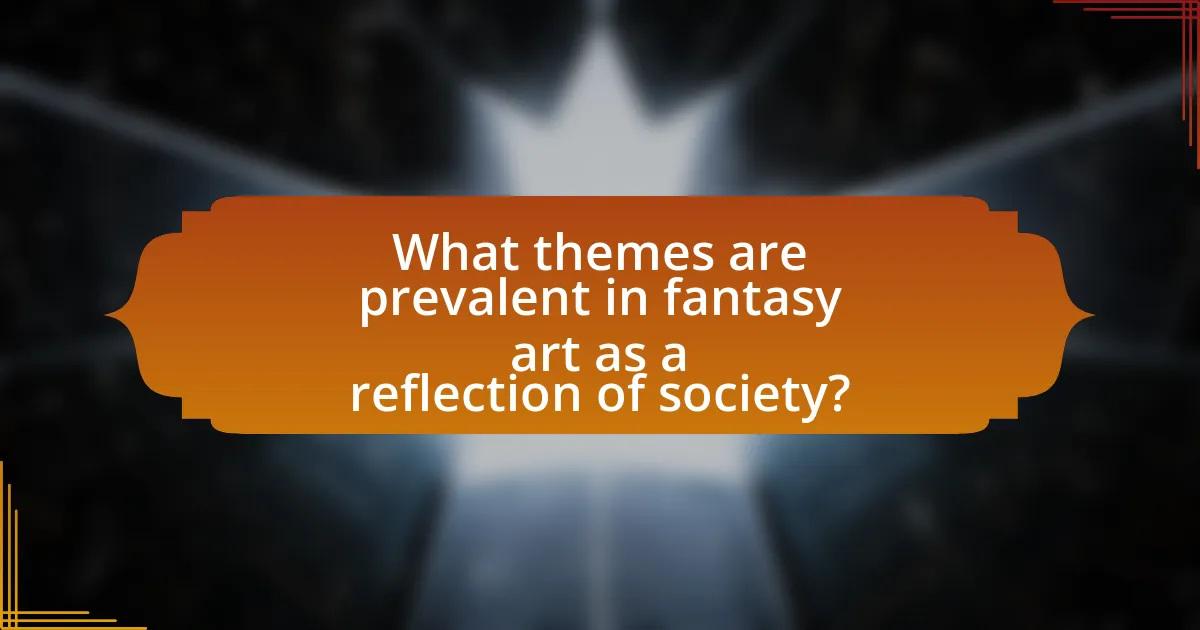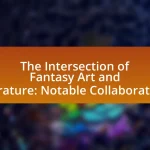The article examines how fantasy art serves as a reflection of societal changes, highlighting its ability to visually represent cultural values, fears, and aspirations across different historical contexts. It explores the influence of significant movements such as the Industrial Revolution, the Renaissance, and feminism on the themes and styles of fantasy art. Additionally, the article discusses the role of technology in shaping contemporary fantasy art, the representation of diversity, and how fantasy art critiques political structures and addresses social issues. Key symbols and landscapes in fantasy art are analyzed for their societal implications, and the article emphasizes the importance of exhibitions in enhancing the understanding of these themes.

How does fantasy art reflect societal changes?
Fantasy art reflects societal changes by visually representing cultural values, fears, and aspirations of different eras. For instance, during the Industrial Revolution, fantasy art often depicted mechanized landscapes and dystopian themes, mirroring societal anxieties about technology and urbanization. In contrast, contemporary fantasy art frequently embraces themes of diversity and inclusivity, reflecting modern societal movements towards equality and representation. This evolution in artistic expression serves as a barometer for societal shifts, illustrating how artists respond to and critique the world around them.
What historical contexts influence fantasy art?
Historical contexts that influence fantasy art include mythology, folklore, and significant cultural movements. For instance, the Romantic movement of the 19th century emphasized emotion and individualism, which inspired artists like Gustave Moreau and Arthur Rackham to create fantastical imagery rooted in mythological themes. Additionally, the rise of industrialization and urbanization prompted a longing for nature and the supernatural, leading to a resurgence of fantasy elements in art. The impact of World War I and II also shaped fantasy art, as artists sought to escape the harsh realities of war through imaginative worlds, exemplified by the works of artists like Maxfield Parrish. These historical contexts provide a framework that informs the themes, styles, and subjects present in fantasy art.
How did the Renaissance shape modern fantasy art themes?
The Renaissance significantly shaped modern fantasy art themes by reintroducing classical mythology and humanism, which emphasized individualism and the exploration of the human experience. Artists like Botticelli and Michelangelo drew inspiration from ancient Greek and Roman texts, creating works that celebrated mythological figures and narratives, thus laying the groundwork for contemporary fantasy art that often incorporates similar themes of heroism, adventure, and the supernatural. The Renaissance’s focus on realism and perspective also influenced modern fantasy art, as artists strive to create immersive worlds that blend the fantastical with believable environments, enhancing the viewer’s experience.
What role did the Industrial Revolution play in fantasy art evolution?
The Industrial Revolution significantly influenced the evolution of fantasy art by introducing new technologies and societal changes that artists responded to creatively. This period, marked by rapid industrialization and urbanization, led to a shift in themes within fantasy art, as artists began to incorporate elements of machinery, urban landscapes, and the juxtaposition of nature and industry. For instance, the works of artists like Gustave Doré and later, the Pre-Raphaelite Brotherhood, reflected a fascination with both the romanticized past and the emerging industrial world, showcasing fantastical elements alongside industrial motifs. This blending of the fantastical with the realities of industrial life allowed fantasy art to serve as a commentary on the societal transformations occurring during the 19th century, illustrating the tension between progress and nostalgia.
How do cultural movements impact fantasy art styles?
Cultural movements significantly influence fantasy art styles by shaping the themes, aesthetics, and narratives depicted in the artwork. For instance, the Romantic movement of the 19th century emphasized emotion and nature, leading to fantasy art that often featured dramatic landscapes and mythical creatures, reflecting society’s yearning for the sublime and the supernatural. Similarly, the rise of Surrealism in the early 20th century introduced dream-like imagery and bizarre juxtapositions, which can be seen in fantasy art that explores the subconscious and challenges reality. These shifts in artistic expression are often responses to broader societal changes, such as technological advancements, political upheaval, or shifts in philosophical thought, demonstrating how cultural contexts directly inform the evolution of fantasy art styles.
What are the key characteristics of fantasy art during the feminist movement?
Key characteristics of fantasy art during the feminist movement include the portrayal of strong female protagonists, the subversion of traditional gender roles, and the exploration of themes related to female empowerment and identity. Artists such as Judy Chicago and Faith Ringgold utilized fantasy elements to challenge societal norms and depict women in positions of power and agency. This period saw an emphasis on collaborative works and community engagement, reflecting the collective nature of the feminist movement. The use of vibrant colors and imaginative landscapes often served to create alternative realities where women could transcend patriarchal constraints, reinforcing the movement’s goals of liberation and self-expression.
How has technology influenced the creation of fantasy art?
Technology has significantly influenced the creation of fantasy art by providing artists with advanced tools and platforms for expression. Digital painting software, such as Adobe Photoshop and Procreate, allows for greater flexibility and experimentation, enabling artists to create intricate designs and vivid colors that were difficult to achieve with traditional media. Additionally, 3D modeling software like Blender and ZBrush has revolutionized the way fantasy art is conceptualized, allowing for the creation of detailed characters and environments that can be manipulated in three dimensions. The rise of social media platforms has also expanded the reach of fantasy artists, facilitating community engagement and collaboration, which fosters innovation and diversity in artistic styles. These technological advancements have not only enhanced the quality of fantasy art but have also democratized its creation, allowing a broader range of voices to contribute to the genre.

What themes are prevalent in fantasy art as a reflection of society?
Prevalent themes in fantasy art as a reflection of society include escapism, the struggle between good and evil, and the exploration of identity. Escapism is often depicted through fantastical landscapes and mythical creatures, allowing individuals to transcend their everyday realities. The struggle between good and evil is a recurring motif, illustrating societal conflicts and moral dilemmas, which can be traced back to classic literature and folklore. Additionally, the exploration of identity is represented through diverse characters and narratives, reflecting contemporary issues such as gender, race, and cultural heritage. These themes collectively mirror societal values, fears, and aspirations, making fantasy art a significant lens through which to understand cultural dynamics.
How does fantasy art address social issues?
Fantasy art addresses social issues by using imaginative visuals to critique and reflect societal norms, injustices, and cultural narratives. For instance, artists often depict themes such as inequality, environmental degradation, and identity struggles through fantastical elements that resonate with audiences on an emotional level. A notable example is the work of artists like Brian Froud and Julie Bell, who incorporate social commentary into their fantasy landscapes and characters, prompting viewers to engage with real-world issues in a more accessible manner. This approach allows for a deeper exploration of complex topics, making them relatable and thought-provoking, thereby fostering dialogue and awareness around pressing social concerns.
What representations of diversity can be found in contemporary fantasy art?
Contemporary fantasy art showcases a variety of representations of diversity, including racial, gender, and cultural diversity. Artists increasingly depict characters from various ethnic backgrounds, challenging traditional Eurocentric portrayals and reflecting a more global perspective. For instance, works by artists like Yuko Shimizu and Kadir Nelson highlight characters of different races and ethnicities, promoting inclusivity. Additionally, gender diversity is represented through non-binary and strong female characters, as seen in the art of artists like Jen Bartel and Fiona Staples, who create empowered female figures in fantastical settings. Cultural diversity is also evident, with artists incorporating elements from various mythologies and folklore, such as African, Asian, and Indigenous narratives, thereby enriching the fantasy genre and making it more relatable to a broader audience. This shift in representation aligns with societal changes towards greater acceptance and celebration of diversity in contemporary culture.
How does fantasy art critique political structures?
Fantasy art critiques political structures by using allegory and symbolism to reflect societal issues and power dynamics. For instance, works like George Orwell’s “Animal Farm,” illustrated in various fantasy art forms, depict the corruption of ideals and the manipulation of power, showcasing how authoritarian regimes can emerge from revolutionary movements. Additionally, fantasy art often portrays dystopian worlds that serve as cautionary tales about totalitarianism, as seen in the visual representations of works like “The Handmaid’s Tale,” which highlight the consequences of oppressive governance. These artistic expressions provide a platform for commentary on contemporary political realities, encouraging viewers to question and analyze the structures that govern their lives.
What symbols are commonly used in fantasy art to convey societal messages?
Common symbols used in fantasy art to convey societal messages include dragons, which often represent power and fear; swords, symbolizing conflict and heroism; and mythical creatures like unicorns, representing purity and hope. These symbols serve to reflect societal values, fears, and aspirations. For instance, dragons have been historically depicted in various cultures as embodiments of chaos or guardians of treasure, illustrating the duality of power in society. Swords frequently symbolize the struggle for justice or the fight against oppression, resonating with themes of heroism in societal narratives. Additionally, unicorns often symbolize the ideal of innocence and the quest for a better world, mirroring societal desires for peace and purity amidst chaos.
How do mythical creatures represent societal fears or aspirations?
Mythical creatures symbolize societal fears and aspirations by embodying the collective anxieties and desires of a culture. For instance, dragons often represent fear of the unknown or chaos, reflecting historical contexts such as invasions or natural disasters, while unicorns symbolize purity and hope, representing aspirations for peace and harmony. These representations can be traced back to various mythologies; for example, the dragon in European folklore often signifies a formidable adversary, mirroring societal fears during times of conflict, whereas the unicorn appears in medieval texts as a symbol of unattainable ideals. Thus, the portrayal of these creatures in art and literature serves as a mirror to the values and concerns of the societies that create them.
What role do landscapes play in reflecting societal values in fantasy art?
Landscapes in fantasy art serve as a visual representation of societal values, illustrating cultural beliefs, ideals, and conflicts. For instance, lush, vibrant landscapes often symbolize prosperity and harmony, reflecting a society that values nature and abundance, while desolate or chaotic environments can depict societal fears or moral decay. Historical context supports this, as seen in the works of artists like Caspar David Friedrich, whose landscapes often conveyed Romantic ideals of nature’s sublime power, mirroring the 19th-century fascination with individualism and the natural world. Thus, landscapes not only enhance the narrative of fantasy art but also act as a mirror to the values and concerns of the society from which they emerge.
How can exhibitions enhance the understanding of fantasy art’s societal reflections?
Exhibitions enhance the understanding of fantasy art’s societal reflections by providing a curated space where viewers can engage with artworks that illustrate cultural narratives and social issues. Through thematic organization, exhibitions can highlight how fantasy art mirrors societal values, fears, and aspirations, allowing audiences to draw connections between the art and contemporary societal contexts. For instance, exhibitions often include artist statements and contextual information that explain the influences behind the works, such as historical events or social movements, thereby deepening the viewer’s comprehension of the art’s relevance. Additionally, interactive elements and discussions during exhibitions can facilitate dialogue among attendees, further enriching their understanding of how fantasy art serves as a commentary on societal changes.
What are the key elements of a successful fantasy art exhibition?
The key elements of a successful fantasy art exhibition include a cohesive theme, diverse artistic styles, engaging narratives, interactive elements, and effective marketing strategies. A cohesive theme ensures that all artworks resonate with a central concept, enhancing the viewer’s experience. Diverse artistic styles attract a broader audience and showcase the range of creativity within the fantasy genre. Engaging narratives, whether through artist statements or accompanying texts, provide context and deepen the viewer’s understanding of the works. Interactive elements, such as workshops or digital displays, encourage audience participation and foster a connection with the art. Effective marketing strategies, including social media promotion and partnerships with relevant organizations, increase visibility and attendance, which are crucial for the exhibition’s success.
How does curation influence the viewer’s perception of societal themes in fantasy art?
Curation significantly influences the viewer’s perception of societal themes in fantasy art by selectively presenting artworks that highlight specific narratives and contexts. Through the arrangement and choice of pieces, curators can emphasize particular societal issues, such as identity, power dynamics, or environmental concerns, thereby shaping the audience’s understanding and interpretation of these themes. For instance, an exhibition that focuses on climate change in fantasy art may include works that depict dystopian futures, prompting viewers to reflect on current environmental challenges. This targeted curation not only directs attention to certain societal themes but also encourages critical engagement, as evidenced by studies showing that curated exhibitions can alter viewer perceptions and provoke discussions around the highlighted issues.
What interactive elements can be included to engage audiences with societal issues in fantasy art?
Interactive elements that can engage audiences with societal issues in fantasy art include augmented reality experiences, interactive installations, and audience participation activities. Augmented reality can overlay digital content onto physical artworks, allowing viewers to explore societal themes in depth, such as environmental issues or social justice, by interacting with the art through their devices. Interactive installations can invite audiences to contribute their thoughts or experiences related to the societal issues depicted, fostering a dialogue around the themes presented. Audience participation activities, such as workshops or discussions, can further enhance engagement by encouraging individuals to reflect on and share their perspectives on the societal issues represented in the fantasy art. These methods have been shown to increase viewer investment and understanding, as evidenced by studies indicating that interactive experiences can lead to deeper emotional connections with the subject matter.
What practical tips can enhance the experience of visiting a fantasy art exhibition?
To enhance the experience of visiting a fantasy art exhibition, attendees should engage with the artwork by reading accompanying descriptions and artist statements, as this provides context and deepens understanding. Engaging with the art allows visitors to appreciate the themes and societal reflections embedded in the pieces, which is crucial in a genre that often critiques or mirrors cultural shifts. Additionally, participating in guided tours or artist talks can offer insights that enrich the viewing experience, as these formats often reveal the creative processes and intentions behind the works. Research indicates that interactive experiences, such as workshops or discussions, significantly increase visitor satisfaction and retention of information, making them valuable components of an exhibition visit.
How can visitors prepare to engage critically with the themes presented in fantasy art exhibitions?
Visitors can prepare to engage critically with the themes presented in fantasy art exhibitions by researching the historical and cultural contexts of the artworks. Understanding the societal changes that influence fantasy art, such as shifts in technology, politics, and social norms, allows visitors to analyze how these themes are represented visually. For instance, examining the evolution of fantasy art from the Romantic period to contemporary works reveals how artists respond to their environments, reflecting societal anxieties and aspirations. Engaging with critical essays or artist statements related to the exhibition can further enhance visitors’ ability to interpret the themes effectively.
What questions should visitors consider while exploring fantasy art in exhibitions?
Visitors should consider questions such as: What themes are prevalent in the fantasy art displayed? Understanding the themes helps to connect the artwork with societal changes and cultural narratives. Additionally, visitors should ask how the artists’ backgrounds influence their work, as personal experiences often shape artistic expression. Another important question is how the fantasy elements reflect contemporary issues, which can reveal insights into societal values and concerns. Lastly, visitors should consider the historical context of the artworks, as this can provide a deeper understanding of the evolution of fantasy art and its relationship with societal changes.


